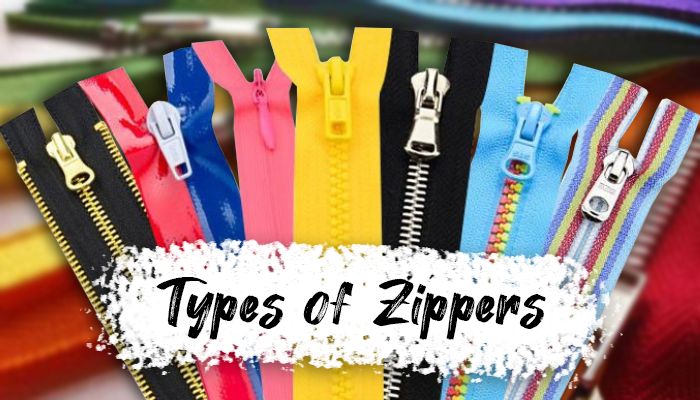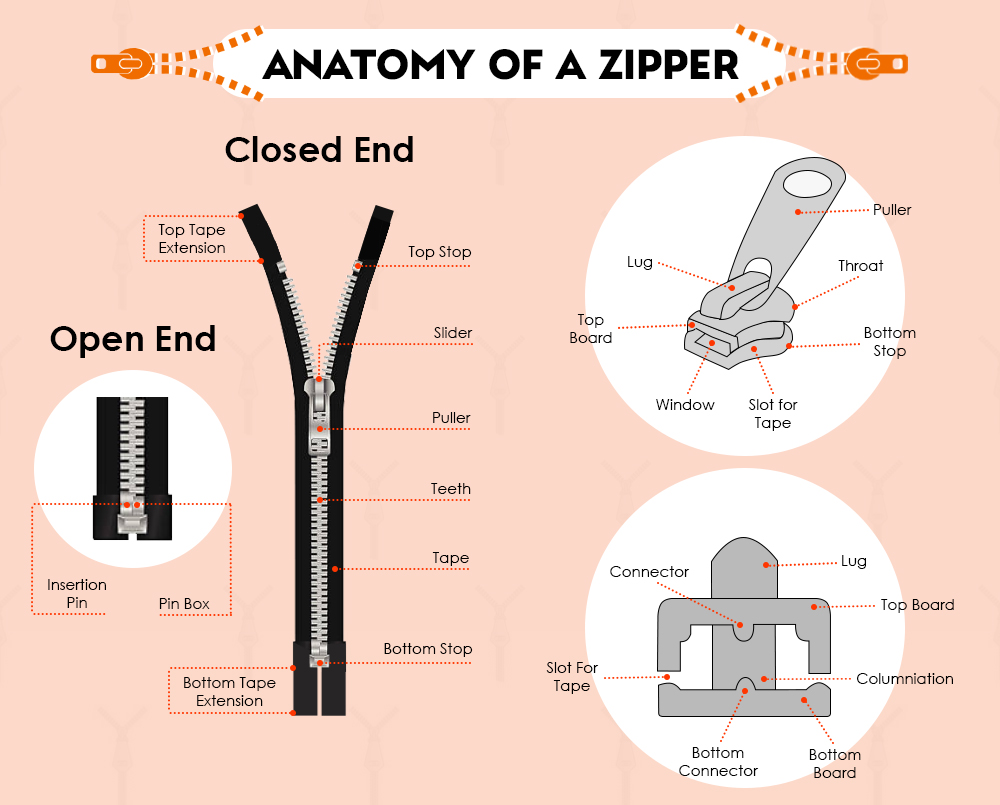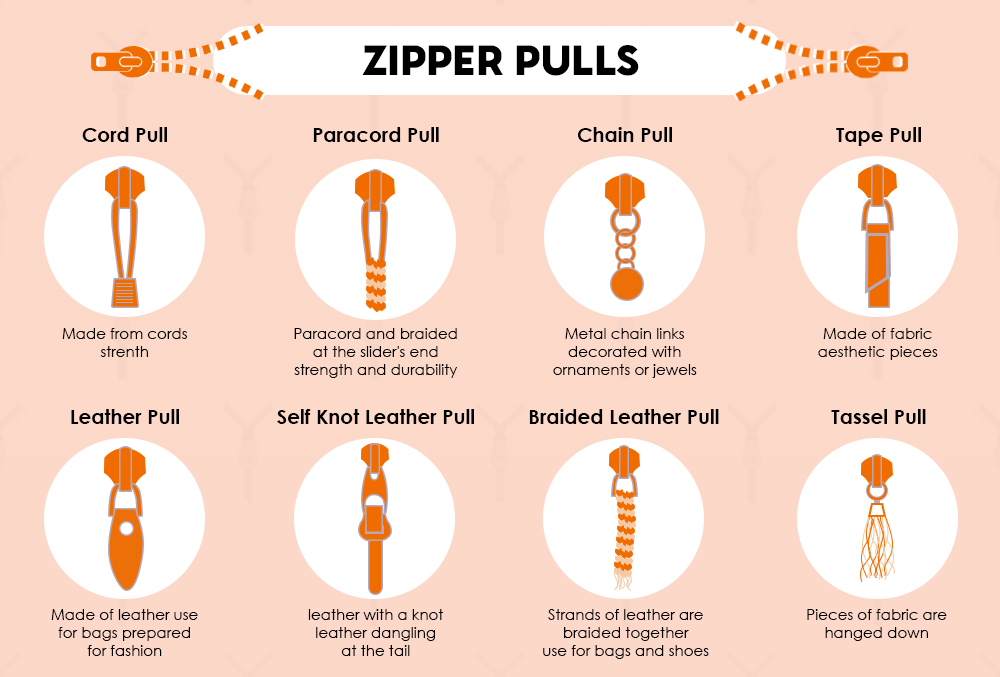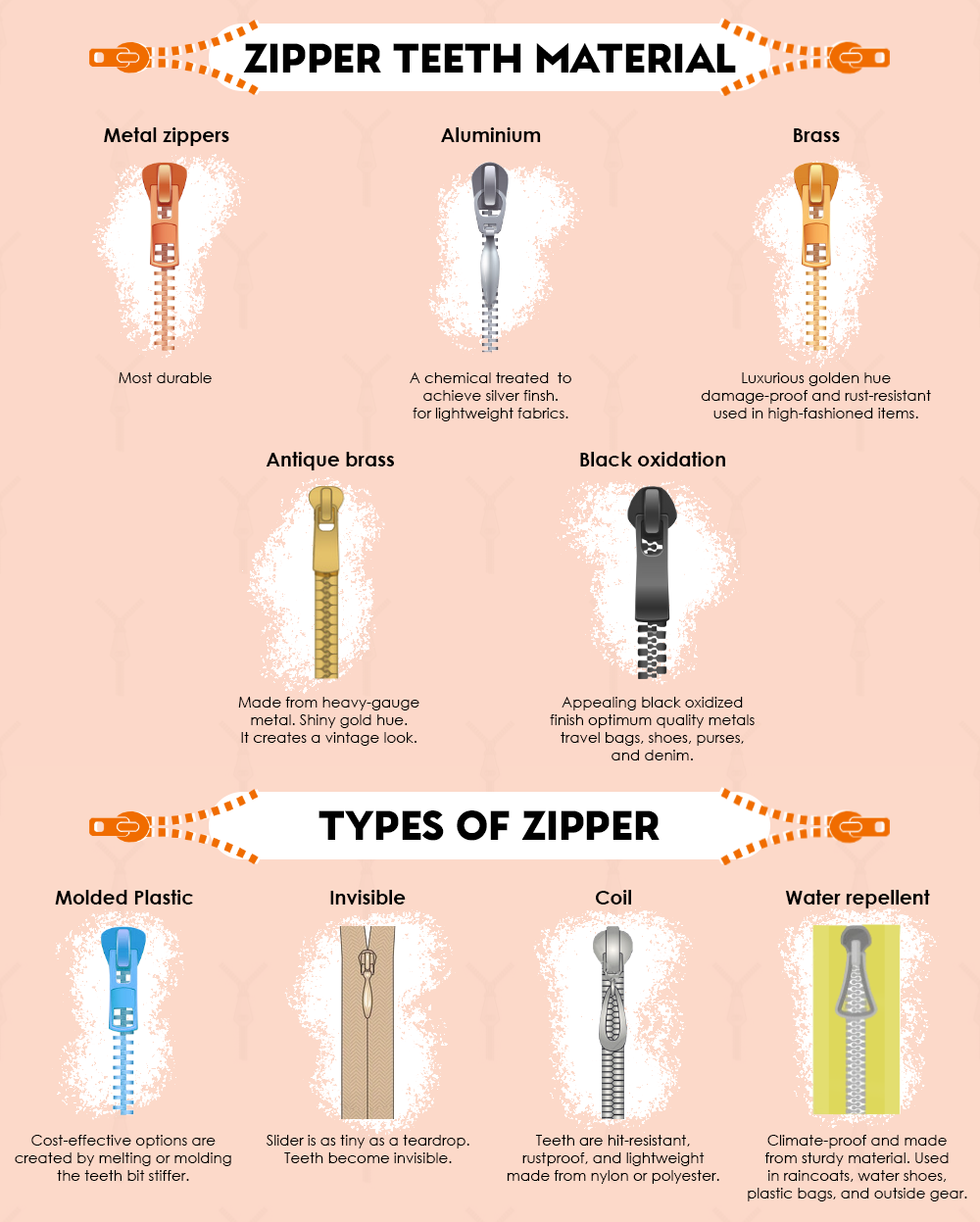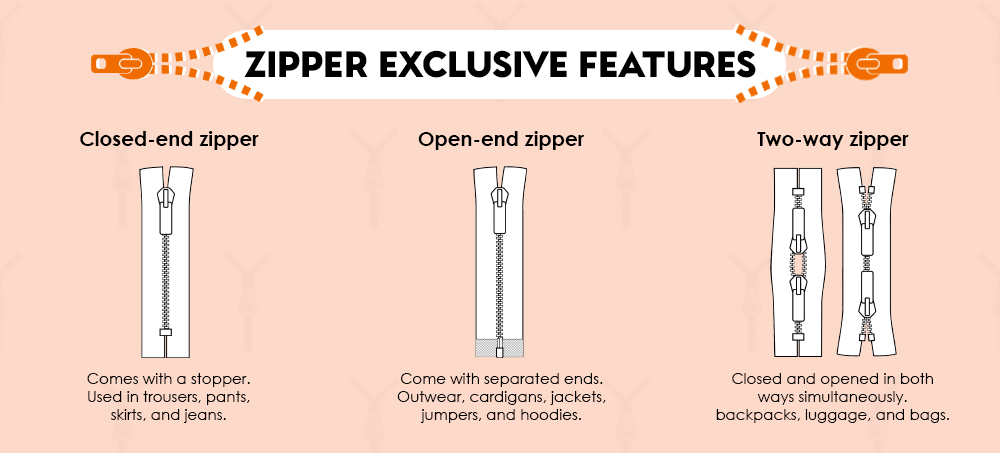The best zipper guide – everything you need to know from types to size
Can you imagine the security of your pant, jacket, backpack, or sleeping bag without a zipper? No, right? After all, the design of a zipper makes or breaks an outfit. So a steady, high-quality, and reliable zipper depends on many factors like the type of fabric and design.
This fastening device features two flexible plastic or metal stripes with interlocking projections. A zipper helps you to close or open it by pulling the slide to fasten your garments. Nowadays, modern designers also utilize it to give any outfit a stylish look. The size and function of each other vary according to their functionality.
How does a zipper work?
You must have seen the teeth with a hook in each side of a zipper while the slider runs up and down on the zipper track. While you are closing the zipper track, the slider pushes the teeth. On the other hand, the slider goes in the opposite direction to separate the zipper teeth. That is why the zipper teeth should always be the same size. Then only it will work perfectly.
Breaking a high-quality zipper is a herculean task. That’s why the teeth size is crucial to make the whole mechanism work appropriately. Let’s dig deep into it and get to know the anatomy of a zipper.
A. Anatomy of a Zipper
A zipper consists of these five elements.
1. Zipper Tape
A zipper tape is crafted from polyester, blended fiber, cotton, or nylon and is attached to the zipper by sewing it. It comes with high lateral strength.
2. Teeth or Chain
We already know that a zipper is closed or opened by a chain or teeth. These are made from aluminum, plastic, nylon, or brass.
3. Slider Body
The slider’s work is to open or close the chain or teeth.
4. Slider Pin
Sliders work perfectly without any unwanted movement because of this slider pin.
5. Stopper
The slider doesn’t run out of a zipper because of this stopper as it controls the slider.
B. Types of Zippers Solely Based on Sliders
1. Non-lock Slider
This one is one of the most simple but stylish types of sliders with no locking system. So it will not be locked when zipped.
2. Auto-lock Slider
This one will get automatically locked when the user stops using the pull tab.
3. Pin-lock Slider
In the system, a pin is inserted into the lock to prevent the slider’s unwanted movement.
4. Double Pull Slider
The double pullers also prevent the slider from moving unwantedly, as the lock system comes with a pin.
5. Key Lock Slider
This one is a bit different from others as this lighter material comes with an entirely separate key that prevents the slider from moving. This system is excellent for locking your essential documents in a bag.
C. Different Types of Zipper Pulls
The name says it all. A zipper puller helps us to pull the slider up and down. But the pulls come in diverse varieties and designs. Let’s check it out.
1. Cord Pull
Cord pulls are made from cords. If you notice a camping gear or a rain jacket thoroughly, you will find a pull fastened to the slider’s crown, and the other side is attached at its ends with a metal or a plastic piece.
2. Paracord Pull
This one is usually made of paracord and braided at the slider’s end. Paracord pull is attached to camping gear for strength and durability.
3. Chain Pull
Chain Pull is a girl’s personal favorite as it comes with metal chain links decorated with ornaments or jewels. Fashionistas love to use these stunners.
4. Tape Pull
Tape pulls are attached to aesthetic pieces. These durable pulls are made of fabric. Its two separate strands hang down from the slider, and one stand cuts the other diagonally.
5. Leather Pull
You must have noticed this leather pulls in the bags available in different shapes and sizes. These aesthetically pleasing designs are prepared for fashion.
6. Self Knot Leather Pull
They are also made from leather with a knot. If someone finds a belt too long, he can also create a similar look of leather dangling at the tail of that belt.
7. Braided Leather Pull
When strands of leather are braided together, these braided leather pulls create a beautiful look. These are attached to a bag for aesthetic purposes.
8. Tassel Pull
When different pieces of fabric are hanged down to form a beautiful tassel look, we call it a tassel pull which is in trend right now.
D. Different Types of Zippers Based On Element/Teeth Material
- Metal Zippers
- Aluminum Finish
- Brass Finish
- Antique Brass
- Black Oxidation
- Molded Plastic Zippers
- Invisible Zippers
- Coil Zippers
- Water Repellent Zippers
We can divide these zippers into three different categories depending on their three distinct materials.
1. Metal Zippers
Metal zippers are probably the most durable out of these three categories that add a touch of luxury. We can divide these relatively heavy zippers into two categories depending on their material and the manufacturing process.
- The first category is of large metal teeth that can be profiled or flat. These are usually made from nickel-free white brass, standard brass, aluminum, or nickel.
- The second category of teeth is usually made from non-ferrous metal like zinc, in which die-casting is possible.
The finishing of these luxurious zippers is also different depending on the material.
2. Aluminum Finish
These zippers are given a chemical treatment to achieve that antique silver finish. As a result, these items become 40% lighter. It’s a great pair of lightweight fabrics.
3. Brass Finish
These are constructed by using a typical combination of zinc and copper known as a brass alloy. After enduring this chemical treatment, these zippers achieve a luxurious golden hue that is damage-proof and rust-resistant. These zippers are usually used in high-fashioned items.
4. Antique Brass
These heavy-duty materials are made from heavy-gauge metal. The teeth of these zippers come with a shiny gold hue. It creates a vintage look.
5. Black Oxidation
Optimum quality metals are used to give these zippers to give them an attractive and appealing black oxidized finish. This type of zippers is usually used in travel bags, shoes, purses, and denim to take their look to the next level.
6. Molded Plastic Zippers
Molded plastic zippers are one of the most cost-effective options as these are constructed from cheap materials. These zippers are created by melting or molding the teeth directly onto the tape of the zipper. This one is a bit stiffer because of the teeth’ shape.
We can divide molded plastic zippers into five different categories.
- LFC or L-type- Their Ruhrmaan/meander type coil can easily distinguish these zippers. If you closely look at the edge of its carrier tape, you will find this coil stitched around it.
- CFC- CFC zippers can easily be distinguished again with carrier tape where the spiral coil is stitched only at one side.
- Woven-in coil- In these zippers, the coil is directly woven into its carrier tape.
- Plastic- Usually found in molded zippers, the teeth of these zippers are made from polyacetal. Therefore, the coil is molded directly onto the carrier tape.
- Plastic extruded- This is a kind of zipper in which a teeth string is extruded first, and then it is directly stitched onto the carrier tape.
These types of sleepers are found in home furnishing bags and apparel.
7. Invisible Zippers
One of the most common fashionable products is an invisible zipper attached to the back of a chic dress or pants or skirts. These superior materials are usually stitched in such a manner that the onlookers can only see a hairline seam from outside. The slider is as tiny as a teardrop. So once the zipper is closed, the teeth become invisible. But it does not vanish. The teeth are just hidden on the zipper’s backside.
8. Coil Zippers
These are also like common zipper types. The teeth are hit-resistant, rustproof, and lightweight, and originally made from nylon or polyester. Different sizes are available because of their great flexibility. These zippers can be used in any fashion, bags, zip bags, automobiles, sports goods, tents, and canvas goods.
9. Water Repellent Zippers
Water-repellent zippers are climate-proof and made from sturdy material. These can withstand any rough weather. That is why they are used in raincoats, water shoes, plastic bags, and outside gear.
E. Different Types of Zippers Based On Exclusive Features
If we measure zippers according to their features, we can divide them into three different categories.
1. Closed-end Zippers
Closed-end zippers are nothing but ordinary zippers that cannot be separated at the bottom. It comes with a stopper attached to its bottom to stop the pull from moving and separating. Closed-end zippers are usually used in trousers, pants, skirts, and jeans.
2. Open-end Zippers
Just opposite to close and zippers, open-end zippers come with separated ends, and these ends are joined by a pin that is available on the lower part of the zipper. You can quickly close this zipper by using its slider. Open-end zippers are usually found on outwear, cardigans, jackets, jumpers, and hoodies.
3. Two-way Zippers
Two ways zippers are also known as dual or double zippers. These are usually made from metal or plastic and can be closed and opened in both ways simultaneously. These zippers are typically used on different types of backpacks, luggage, and bags.
F. Useful Hacks to Fix Zipper Problems
1. How to operate a zipper without any hassle?
Operating a zipper is a piece of cake. All you need to do is utilize your two hands and insert a pin into the retainer box. Hold the jacket bottom with one hand and the slider with the other, and then pull the tab to close the zipper. Very simple, isn’t it?
2. What to do if the slider is not working?
If the slider is only going up, then you should grab the pillars and close the slider together. Running lubricants on the teeth like zipper glide, lip balm, graphite pencil, bar soap, wax, or baby powder is truly useful.
3. What to do if zipper pills only going to the bottom?
Take a rubber band or a key ring and slide it through the zipper pull. This is one of the simplest ways to fix it.
4. What to do if the zipper is completely jammed?
The most helpful way to fix it is by rubbing a graphite pencil on the zipper teeth.
5. What to do if a self-opening zipper is not working?
The best problem solver is your hair spray. Straight on the zipper teeth and gently pull it.
Take-home advice
- If the tooth of a plastic zipper breaks, you cannot fix it while the metal ones are fixable. But you will be amazed to know that plastic visitors typically last longer than metal ones as plastic ones have the power to withstand dirt, UV rays, and corrosion.
- If your zipper gets sticky, instantly apply lubricant to fix it.
- Don’t forget to use seam tape on the fabric before sewing your zipper to hold it in place perfectly.
- Always use a pressing cloth before pressing your garment with zipping. It is necessary for the protection of the teeth.
- While sewing, pay heed to the metal stopper pieces as they can easily break your needle.
Cheryl Carter
Latest posts by Cheryl Carter (see all)
- Custom Leather Patches for Hats: Elevate Your Style by Choosing the Perfect - February 27, 2024
- Types of Curtain Pleats: Explore and Elevate Your Interior Design - February 6, 2024
- Korean Perm Hairstyles Male: Get the K-Pop Look - November 24, 2023
